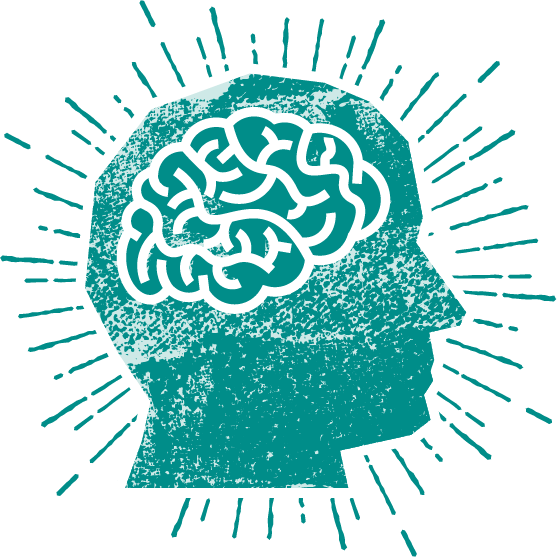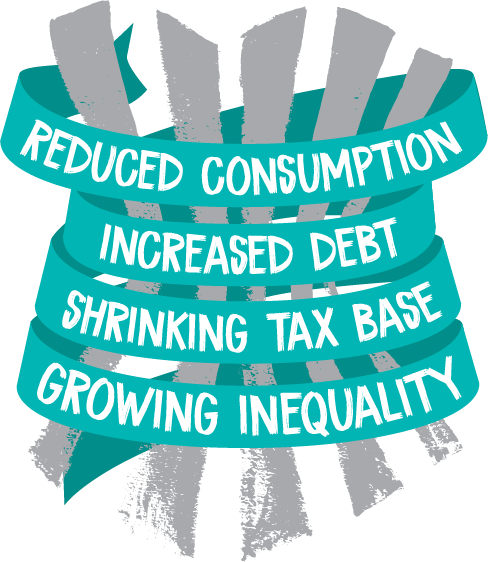Understand the Corset Theory

The Corset Economy is a vision of what is happening to the economy and how this could unfold for us all. Underpinning this is the Corset Theory: the squeeze of the global economy.
This corseting means a vicious cycle of diminishing consumption and production and growing inequality. The greater the corseting and loss of the mass middle, the less wealth is created and the smaller the engine for prosperity and economic growth becomes.
The Corset Theory is based on two interconnected concepts—the mass middle, and the consumption / production flywheel.
- The mass middle, those in a society with sufficient disposable income to create a stable consumer market. This mass middle underpins both private and public consumption.
- The consumption / production flywheel, where mass consumption of goods and services drives mass production of goods, infrastructure and services. Mass consumption requires mass production and vice versa. This flywheel has the potential to produce wealth that circulates through the economy.
When the mass middle and the flywheel work in synergy, it offers the potential for greater equality, technological progress, rising democracy, improved quality of life and wealth creation.
The more out of alignment the mass middle and flywheel are, the greater the corseting potential – and with it, increased inequality and social tensions.

The mass middle
The mass middle is the foundation of the economy. This mass comprises those with sufficient discretionary income to create a stable consumer market. They are neither rich nor poor, but they have sufficient wealth or income security to be able to consume the wide range of goods and services available in the marketplace. This consumption is not just ‘stuff’, but also housing, education, health and long-term care.
Attributes of a mass middle
Magnitude
First, a market economy requires consumers in large numbers. Without certainty about the market size, it would be foolhardy to make the necessary financial and technological investments.
Purchasing power
Second, these potential customers need purchasing power—the ability to consume. Without discretionary income, or certainty that their future income will support their purchases, they do not constitute a sustainable market.
Desire to consume
Third comes desire. The mass market has to want to consume the products and services on offer. This is where marketing and advertising plays a key role—and also inbuilt obsolescence.

The traditional mass middle emerged in the industrialised economies. While initially wedged between the rich and poor, this new ‘middling’ group extended in scale and scope. As it grew, so too did mass middle consumption, driving economic growth. However, this has changed.
Technological change and globalisation created a fundamental shift that has been accelerating over the past four decades. The ‘lower middle class’ of the rich world have been the real losers from globalisation. This shift of economic power has reduced the traditional mass middle substantially both in size and purchasing power.
The full implications of this corseting effect have not yet materialised, masked by growing private and public indebtedness. It is now further exacerbated by the demographics of a large aging population, living longer, and a shrinking youth population.

What is the difference between
the mass middle and middle class?
The middle class as a term is often used to describe an economic status, however it can be contentious with a social and cultural overtones, and no consensus on definition. We use the term mass middle to denote a purely economic group. This might or might not include the middle class, depending on the level of corseting. But it will also include others who fall into this economic category due to redistribution e.g. “middle class” young people with unstable incomes, or “working class” older people with large pension pots.

What does a corseted mass middle mean?
The mass middle is an integral part of the system, like the keystone species of an ecosystem. In any ecosystem, the “keystone” is an organism that holds the system together. When an ecosystem loses the keystone species it can no longer function the way it used to. This could mean the end of the ecosystem, or an invasive species might take over and dramatically shift the ecosystem in a new direction. In our economic ecosystem, the mass middle is our “keystone”. There are plenty of examples of economies without a mass middle – just look at history. There have been and are plenty of economies without a mass middle – the few rich, and the many poor.
Further questions
What about the global middle?
A new global mass middle, which is sometimes referred to as the ‘global middle class’, has emerged. It is growing the fastest in the emerging economies of Asia. This global mass middle is perceived by many to be a replacement mass middle market—one of gigantic size and immaturity, which is excellent news for global economic growth prospects. However, this global mass middle is not synonymous with its predecessor.
How does the global mass middle differ from the traditional mass middle?
There are several differences: magnitude and ability to afford consumption. The definition of the global mass middle varies widely, and this determines its magnitude. While the mass middle no longer lives in abject poverty, and living costs globally are typically lower in purchasing power parity terms, they are still relatively poor compared to the traditional mass middle. In fact, many lie below the poverty line in terms of industrialised world definitions.
The global mass middle has proportionately less discretionary income. In many cases they pay separately for a range of public services, such as education, healthcare, security and energy generation that are publicly funded in the industrialised world. Income security is also a critical issue. There is a limited social safety net and a substantial number of ‘floaters’ that could easily sink back into poverty. This means the global mass middle cannot afford and sustain the levels of mass consumption that we associate with the traditional mass middle.
But I thought that most people today live in middle-income countries?

That is correct. 75% of people today live in middle-income countries, not low-income countries. There has been a massive shift in wealth to emerging countries, particularly China and South-east Asia, described as the massive success of globalization – see the questions about the ‘global mass middle’ above. The result of this wealth redistribution has been less global inequality (between countries) and greater extremes of inequality within countries. Research shows that within-country inequality, which creates more unequal societies, is most invidious. Social status is determined by the society in which one lives. Levels of trust are lower in unequal societies. There are also more health and social problems.
Why don’t we hear more about the mass middle?
Hopefully we will soon as people wake up. Our capitalist economy began with industrialisation, where the key factor was production and consumption at scale. What created this scale was having a significant mass of people with the means and desire to consume. This mass at the middle of our economy is the cornerstone of economic theory and so obvious we currently take it for granted, assuming it will always just be there. This is no longer the case. If we lose the mass middle it won’t suddenly materialise again.

The production / consumption flywheel
Mass consumption needs mass production and vice versa. Mass middle consumption takes many forms: household spending, public spending on services and infrastructure and business investment. As this consumption increases, producers are able to sell more goods or services, generating increased revenue. The capital accrued can then be used to settle financial obligations, such as debts or taxes; reinvested or earmarked as profit.
With growing business confidence, there is greater incentive to invest in research, development and experimentation. This research and development leads to more innovation, which in turn led to new products, processes and services.
As the quantities of goods and services produced and consumed are increased, the cost per unit is lowered, so creating more affordable goods for mass consumption, and therefore greater demand. With greater demand and new innovations in terms of novel products, processes and services, the cycle then continues. Businesses lobbies governments to invest in better infrastructure, better education and skills training, and regulations that would enable them to maintain or increase competitive advantage against threats from elsewhere. At each stage wealth is created, together with direct and indirect employment for the workforce. This flywheel has created unprecedented level of material comfort, and access to commodities that were previously inaccessible to earlier generations.
Public consumption
Mass middle consumption drove mass production. The resultant economic growth increased tax revenues, which enabled governments to extend the market in two disparate ways.
Redistribution of income
It led to redistribution of income to both the poor and elderly, enlarging the size of the mass middle market of the private sector.
Investment in public infrastructure and services
It led to growing investment in public infrastructure, such as public sanitation systems and roads, as well as public services, such as security, education and health, which created a public sector mass middle market and simultaneously extended the role of the state.
As markets expanded, so too did the range of novel innovations, stoking further desire and providing ever more complex goods and services. Without this cycle of wealth creation, supported by the mass middle and their taxes, public consumption becomes unaffordable.

What about consumption of the [very] rich?
Almost half of all the gains from globalization have gone into the hands of the richest 5 percent of people globally, with almost one-fifth to the top 1 percent. Global plutocrats have been the real winners from globalisation. While the rich do consume, the problem is that there aren’t enough rich people to keep the flywheel turning. The economy needs a mass middle to create the multiplier effect. One dollar in the hands of an ultra-net worth individual will make no difference whatsoever. One dollar in the hands of the mass middle is likely to be spent on goods and services, which in turn generate taxes, which in turn can be redistributed to the poor and elderly, which in turn provides jobs…and so forth.

What happens when the consumption / production flywheel no longer works?
The original consumption / production flywheel took place at the national scale. We now have a global digital economy that has increased complexity and enabled both consumption and production to be dispersed across time and space. But this doesn’t change the fundamentals—without a mass middle to consume, production splutters. There is overproduction, prices plummet and the flywheel will eventually grind to a halt.
Mass consumption needs mass production and vice versa. When consumption and production are delinked, the economic engine of growth is no longer assured.
When consumption and production are delinked, there is an issue of sustainability. Debt can be used to encourage consumption that cannot be afforded. Today, levels of public debt are unprecedented, as income and consumption have become decoupled. At the same time, levels of personal debt are at record highs, due to the lax regulations regarding availability of credit. Without private and / or public employment, propped up by private and / or public debt, the consumption flywheel soon shudders to a halt. Delinked from the production flywheel, the momentum similarly stalls.
But isn’t consumption bad for the environment?
Yes, planetary pressures for a regenerative economy have never been greater. Currently, we use 100 billion tonnes of environmental resources every year, and only 9% is used more than once. This will require rethinking every aspect of the consumption/production flywheel. However, without a social foundation and shrinking inequality humanity is unlikely to achieve this.

